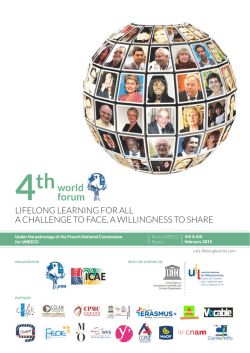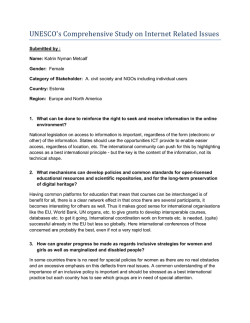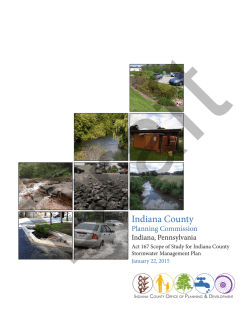
Water as the backbone of quality of life in the cities of the future1
Water as the backbone of quality of life in the cities of the future1 Maciej Zalewski University of Lodz European Regional Centre for Ecohydrology under the auspices of UNESCO, Polish Academy of Sciences According to the UN-Habitat report, in 2008 for the first time in history more than half of the global population lived in cities, with this number expected to reach 60% in the next few years. Progressing urbanization is creating new challenges in terms of the quality of life in a city, as well as residents’ health and ecological safety. The efficiency of traditional engineering solutions used in water and sewage management systems is also called into question. From this perspective, it becomes clear that water and environmental management require innovative solutions based on the integration of engineering expertise with the understanding of biological and hydrological processes. This is the approach of ecohydrology. Key words: ecohydrology, urbanization, water in the city, UNESCO International Hydrological Programme, blue– green infrastructure This chapter contains a synthesis of issues more broadly discussed in these articles: (Zalewski 2013, 2014). 1 Water as the backbone of quality of life in the cities of the future ration adopted at the Rio+20 conference in 2012. These issues have also been addressed in the six In the 21st century, with the rate of exploitation of priority themes of the eighth phase of UNESCO’s environmental resources exceeding the biosphere’s International Hydrological Programme (UNESCO regenerative capacity, the most fundamental ques- IHP), the world’s largest intergovernmental hytion for humans is: what is the future of life and drological project for the years 2014–2021. One of civilization? The first step towards finding the an- these themes (Theme 4: Water and Human Setswer is determining the main threats to the natural tlements of the Future) is dedicated directly and environment. These are: exclusively to cities (UNESCO 2012). Another •alterations and degradation of the basic ecolog- theme is dedicated to ecohydrology (Theme 5: ical processes necessary to sustain life on Earth, Ecohydrology, Engineering Harmony for a Suse.g. the water cycle and the cycle of nutrients, tainable World) with urban ecohydrology as one such as nitrogen, phosphorus and carbon; of its priority areas. It deals with broadly defined •degradation of the biosphere through defor- aspects and interactions between green and blue estation, urbanization and transport; infrastructure and aims to improve the functioning •emission of pollutants; of the urban environment and provide residents •excessive use of all types of environmental with ecosystem services. In its latest publication, resources. UNESCO IHP discusses the world’s water-related The second step and essential prerequisite for the goals in the post-2015 Sustainable Development future of life, civilization and the true improvement Goals proposed by the UN. The following goals in human welfare is understanding were proposed with regard to water: the complexity of interactions be- It is of crucial importance to reduce water pollution from main tween abiotic systems (the physical to understand the comple- sources by 30% at the national level environment), biotic systems and xity of interactions betwe- by increasing urban waste water colsocio-economic systems. It is vital en the abiotic, biotic and lection and purification to at least to prepare a new paradigm and new socio-economic systems. 80%; to increase industrial waste solutions based on interdisciplinary water purification to at least 95%; science. This process was initiated by the Bruntland to reduce diffuse pollution by 30% and undertake report (WCED 1987). The next step was the estab- actions aimed at limiting pollution at its source by lishment of the theoretic fundamentals of hydrology 2030 (UNESCO 2014). Urban water-related issues integrated with ecology, i.e. ecohydrology (Zalewski are given such high priority due to the fact that over et al. 1997, Zalewski 2011) as part of UNESCO’s half of the world’s population lives in urbanized International Hydrological Programme. The process areas and the rate of urbanization has never been was completed with the adoption of the Columbus so fast. Cities are the main water polluters. On the Declaration (EcoSummit… 2013) where the har- other hand, the quality of life in the city is determonization of human needs with the environment’s mined to a large degree by water and greenery, the capacity to absorb stress and regenerate were identi- most important elements of ecohydrological water fied as the primary objective. management that help improve the condition of the natural environment and the ecological safety of city dwellers. Introduction Water and the quality of life Water determines not only environmental quality but also the potential for economic and social development. This was reflected in international commitments such as the UN Millennium Development Goals and “The Future We Want” decla10 | Sustainable Development Applications no 5, 2014 Single-sector vs systemic approach The safe and sustainable future of civilization requires access to food and water, and the production of these depends on the condition and functioning Maciej Zalewski Water-related catastrophes and hydrological changes Groundwater in a changing environment Problems associated with the lack of water or its poor quality Water and human settlements in the future Ecohydrology as the backbone of sustainable development Education is key to assuring water resources Figure 1. UNESCO IHP VIII strategy for the years 2014–2021 of the biosphere. Therefore, it is vital to understand why water is increasingly scarce in some biosphere areas, why fresh water is often polluted and how these trends may be reversed. This is all the more important since the direct consequences of these phenomena are decreased habitat numbers and reduced biodiversity and biological productivity. Unfavourable phenomena are, in many cases, the result of adopting a single-sector approach, with insufficient communication between different users and decision makers as well as the lack of exchange between experts in various disciplines. The lack of dialog between researchers who deal with environmental problems and engineers is particularly challenging as it leads to the excessive use of technology in the environment and is associated with high costs. The result is increasing environmental degradation, quite contrary to the intentions. Furthermore, current research and educational programmes dedicated to the environment all too often fail to emphasize the integrity of ecological processes shaped by evolution, especially the scope and results of man-made modifications and the knowledge on how to reverse these changes. Su- perficial monitoring of the condition of the environment does not allow for the expansion of knowledge necessary for the development of new methods and systemic solutions for sustainable environmental management (Zalewski 2011). New, ecohydrology-based ways of using and shaping water and greenery in urban spaces may be in contrast to the mechanistic approach to water resource management. In light of global climate change, the latter approach leads to a constant increase in costs as well as threats and damage. Sustainable and resident-friendly blue-green cities require a new perspective and therefore the mechanistic/deterministic approach2 must give way to a systemic/evolutionary approach3 defined in the six priority themes of UNESCO IHP (figure 1). Sustainable development is often impeded by the failure to appreciate its local dimension. The Nobel laureate, Elinor Ostrom, was among the researchers who highlighted the importance and high effectiveness of local economic systems. She showed that any community living in particular environmental conditions had to figure out its own system for the sustainable use of natural resources and sustainable The mechanistic/deterministic approach assumes the achievement of one specific goal in limiting environmental management-related threats while ignoring the interactions between the environment and infrastructure. 2 The systemic/evolutionary approach is a comprehensive approach that assumes the achievement of more than one goal and includes interactions between the natural environment and infrastructure. 1 Sustainable Development Applications no 5, 2014 | 11 Water as the backbone of quality of life in the cities of the future coexistence within the ecosystems. The structure of ecosystems and their potential to provide humans with services result from specific geomorphological processes, climate, historically determined cultural patterns and the intensity of usage. Maintaining the single-sector mechanistic/deterministic approach could cause the functioning of the biosphere to deteriorate within a few decades. At the same time, the environment’s capacity to produce, absorb and regenerate is declining, potentially leading to local, regional and global conflicts. processes lead to the loss of ecosystem function and services and reduce their resilience to climate change. The acceleration and intensification of surface runoff in urban catchments results in the increased export of pollutants. These pollutants access rivers directly through increased surface runoff but also indirectly by means of: runoff from stormwater drainage systems that collect water from areas often significantly larger than the physical coverage of the natural drainage basin and exceeding aquifer capacity; runoff from the storm overflows of combined sewer systems that additionally pollutes sewage Challenges associated with water waste aquifers; and illegal discharges of point source pollution. Deteriorated water quality prohibits the in the city development of biodiversity and prevents society The problems described above affect mainly cit- from safely benefiting from the environment. The negative impact of hydrological stress and ies as these are sites of landscape and biosphere degradation responsible for changes in the water pollution is exacerbated by interventions where cycle and the cycle of matter. Moreover, cities face the physical structure of river valley and riverbed contradictory aspirations and priorities of various ecosystem is altered. These interventions are comstakeholder groups. mon in cities and include river development and One of the most important (yet often neglected hydrotechnical works which consist of riverbed by decision makers and practitioners alike) effects of regulation, straightening and development with the the mechanistic approach to urban water manage- use of concrete slabs as well as underground river ment is accelerated rainwater runoff. The result is channelling. At the same time, the cross section of a river is also changed, narrowed accelerated and increased surface runoff and consequently, flooding Any community living in particu- or the river is disconnected from and extreme river flow. Reduced lar environmental conditions has the valley and wetlands etc. The water retention and extended to figure out its own system for development of river valleys for periods of drought prevent the the sustainable use of natural re- residential, industrial or road purfunctioning of green infrastruc- sources and sustainable coexisten- poses is equally damaging. Habiture in cities. Minimum river ce within the ecosystems. tat simplification has a negative flows are also reduced, threateneffect on biodiversity, sediment ing the maintenance of biological life. Additionally, transport and ion exchange with bottom sediments. widespread riverbed regulation leads to the degra- These processes are essential for rivers’ self-purifidation of rivers’ structure and biological function, cation capacity: when these processes are distorted, and reduces their self-purification capacity. Exces- the self-purification capacity of a river decreases. There is much more to the ecological processes sive use of technology in the landscape coupled described above than just impaired landscape aeswith the common practice of dumping sewage and stormwater into rivers increases the cost of water thetics. On a social level, these processes translate resource management and decreased groundwater into a wide range of benefits that account for the recharge (Wagner and Zalewski 2009). Air pol- creation of safe and attractive urban spaces. Reverslution increases and urban heat islands develop, ing the process of natural system degradation may negatively affecting human health (cf. chapter on provide a number of ecosystem services, such as the interrelationships between water and human flood and drought prevention, air and water quality health: Kupryś-Lipińska et al. in this volume). These control, beneficial effects on residents’ health, high 12 | Sustainable Development Applications no 5, 2014 Maciej Zalewski Impact of drainage basin rehabilitation on the reduced incidence of rising rivers and on the efficiency of stormwater treatment in district waste water treatment plants IMPROVED HEALTH (lower incidence of allergy and asthma) AND QUALITY OF LIFE OF RESIDENTS (recreation, mental and physical regeneration) Positive landscape transformation Improved microclimate Increased evapotranspiration due to expanded areas of greenery and reservoirs INCREASED BIODIVERSITY and resistance of urban ecosystems Plantation of common osier Sewer sediment used for biomass production District Waste Water Treatment Plants BIOENERGY REDUCED TRANSPORT OF POLLUTANTS to the Oder river and the Baltic Sea Lateral channel transport of stormwater Sedimentation tanks and hydro-botanical biofilters stormwater retention, reduced incidence of river swelling, water purification Biological treatment of stormwate Meandering channel habitat rehabilitation, increased biodiversity, improved ecological status/potential, self-purification Tanks increased infiltration to groundwater, improved functionality, aesthetics and recreational value of landscape, improved water quality Transport of stormwater via main channel Sedimentation tanks and hydro-botanical biofilters during low water flow increased infiltration to groundwater, improved water quality Figure 2. Concept of urban river rehabilitation where ecohydrology and systemic solutions are used to recreate ecosystem services and the cycles of water and biogenic substances, and to reduce the city’s operating costs. These activities were undertaken within the framework of research and implementation projects developed as a result of collaboration between scientific institutions and the City of Lodz Office quality public space, safe recreational space and reduction in the city’s operating costs. Process-oriented thinking The growing awareness of the need for environmental protection dates back to the industrial era. At the time, it was a response to advancements in biological sciences in the 18th and 19th century and ecosystem degradation caused by intensive exploitation of natural resources. This means that these processes were accompanied by a growing understanding of the determinants and dynamics of ecological succession. However, restoration ecology is not enough to halt the process of environmental degradation in the 21st century. The two principal reasons for this are demographics and economy. It is worth bearing in mind that human impact on the biosphere coupled with the world’s increasing population, global climate change and economic mechanisms that force mass consumption are generating a growing demand for ecosystem services and placing increasing pressure on the environment. The commonly applied criterion of gross domestic product (GDP) has become “an erroneous indicator of national success” as it concentrates on consumption and finance but fails to include natural resources, human welfare, stability and equality (Costanza et al. 2014). The negative changes in cities may be reversed by shifting the paradigm of water management. Wellmanaged waters will become a valuable resource that improves the living conditions and health of residents, especially with the current intensification of climate change. Such policy is made possible by deliberate and safe stormwater retention in the landscape in urban areas (Wagner and Zalewski 2009) and its purification. Science can offer a number of solutions, such as the design of ecosystems that benefit both nature and humans, i.e. ecological engineering (Mitsch 1996; Mitsch and Jorgensen 2004). Wetlands, for example, may be used as a tool to reduce the outflow of pollutants from urbanized Sustainable Development Applications no 5, 2014 | 13 Solutions Costs Water as the backbone of quality of life in the cities of the future Engineering Mechanistic/deterministic approach Ecohydrology and the application of blue-green infrastructure Very high Average Low Evolutionary /systemic approach Very low Low Average High Quality of the urban environment Ecosystems’ capacity to provide services Residents’ quality of life Figure 3. Increased efficiency and reduced costs due to the integration of engineering, ecohydrology and biotechnology areas. The systemic solutions offered by ecohydrology are another option. Ecohydrology for the improvement of quality of life in cities Ecohydrology is an integrated, multidisciplinary field of science oriented at problem solving where the regulation of ecological and hydrological processes is the keyword. It encompasses not only hydrology and ecology, but also geophysics, geology, molecular biology, genetics, geoinformatics, mathematical modelling, socio-economic and legal studies. Ecohydrology studies the links between hydrological processes (such as the water cycle in the urban landscape, river flow, reservoir retention time) and biological processes (e.g. transpiration, evaporation, infiltration to groundwater, transformation from biogenic to biomass, plant growth, biofiltration). This knowledge is used for reciprocal regulation of the abovementioned processes, e.g. to improve the functioning of the environment (including blue and green urban infrastructure). The effective management of water and of the dynamics of nutrient cycling requires the harmonization of conventional hydrotechnical solutions with shaping of the landscape in such a way that ecosystem biotechnology (involving living organisms that transform matter) is applied for process regulation. One example is the construction of 14 | Sustainable Development Applications no 5, 2014 denitrifying barriers with bacteria that reduce the transfer of nitrates to water ecosystems by converting them to gas. The practical implementation of ecological knowledge is also crucial, e.g. to apply microbiology and genetic analysis to harness aquatic microorganisms to mineralize organic matter and biodegrade other types of pollution, e.g. by creating ecotone buffer zones. Such actions require the development and testing of new solutions in ecosystem biotechnology. Studies in urban ecohydrology are one example. The concept of river renaturalization, cascades of reservoirs built over the concept of ecohydrology and the sequential sedimentation/biofiltration system for the treatment of stormwater all emerged as part of research and development efforts. The proposed system acts as a systemic solution where multiple solutions are sought as a result of harmonizing green and blue infrastructure with the city’s social and functional systems (figure 2). Summary Solutions based on the integration of the latest engineering achievements with blue-green infrastructure and applied ecohydrology allow improved effectiveness of corrective measures in urban areas while at the same time reducing their costs (figure 3). It is worth highlighting that the idea of integrating engineering with biological processes to improve the effectiveness and reduce the costs of water management was first proposed by Statzner and Sperling (1993). Solutions of this type also help accelerate the achievement of the requirements of European Union directives (such as the Water Framework Directive), thereby reducing the risk of high penalty payments being imposed on Poland. Furthermore, as the level of education and awareness among society grows, so do the expectations for quality of life. This in turn is increasingly dependent on a sound environment and the proximity of green areas and reservoirs in the city. Green areas and water bodies reduce the operating costs of infrastructure and the number of factors causing asthma and allergy, while also creating opportunities for mental and physical regeneration. Moreover, blue- Maciej Zalewski green infrastructure carries aesthetic and cultural values that are increasingly valuable to residents. In many cities around the globe, river valleys and green areas are perceived by engineers, urban planners and landscape architects as an axis around which urbanized areas are functionally organized. According to Romer (2006), progress, development and innovation depend just as much on technology as they do on ideas and systemic solutions. The sustainable development of our planet requires the development of a holistic and multidisciplinary approach to environmental management. The current mechanistic/deterministic approach must give way to an evolutionary/systemic approach oriented at the application of processes for the sustainable use of resources. Optimizing societal benefit is essential (Zalewski 2013). However, reducing the consumption of energy and natural resources used for technological improvements or other activities remains a priority. As far as methodology is concerned, reductionism and intellectual specialization must be substituted by an integrative, interactive, preventive, adaptive and ethics-based approach. This paradigm shift on various levels should minimize the recent trend of excessive exploitation and excessive use of engineering in the environment and lead to the harmonization of social needs with the environment’s absorptive and regenerative capacity. References Costanza, R., Kubiszewski, I., Giovannini, E. et al., 2014. UNESCO, 2014. Water in the post-2015 development agenda EcoSummit 2012 Scientific Committee, 2013. Wagner, I., Zalewski, M., 2009. Ecohydrological approach Time to leave GDP behind. Nature, 505, pp. 283–285. Harmonization of societal needs with the ecosphere in the Anthropocene Era. Ecohydrology and Hydrobiology, 13, pp. 6–7. Mitsch, W., 1996. Ecological engineering. A new paradigm for engineers and ecologists. In: Schulze, P.C. (ed.), Engineering within ecological constraints, National Academy Press, Washington, D.C. Mitsch, W., Jorgensen, S.E., 2004. Ecological engineering and ecosystem restoration, New York: Wiley. Romer, D., 2006. Advanced macroeconomics, California: McGraw-Hill Irwin. Statzner, B., Sperling, F., 1993. Potential contribution of system-specific knowledge (SSK) to stream management decisions: ecological and economic aspects. Freshwater Biology, 29, pp. 313–342. UNESCO, 2012. Water security: responses to local, regional, and global challenges. Strategy plan, Paris: UNESCO IHP. and sustainable development goals, Paris: UNESCO IHP. for protection and enhancement of ecosystem services for societies at the Pilica catchment demonstration project. Ecohydrological and Hydrobiological Journal, 9, pp. 13–39. WCED (World Commission on Environment and Development), 1987. Our common future, Oxford: Oxford University Press. Zalewski, M., 2011. Ecohydrology for implementation of the UE water framework directive. Proceedings of the Institution of Civil Engineering Water Management, 164, pp. 375–385. Zalewski, M., 2013. Ecohydrology: process-oriented thinking towards sustainable river basins. Ecohydrology and Hydrobiology, 13, pp. 97–103. Zalewski, M., 2014. Ecohydrology, biotechnology and engineering for cost efficiency in reaching the sustainability of biogeosphere. Ecohydrology and Hydrobiology, 14, pp. 14–20. Sustainable Development Applications no 5, 2014 | 15
© Copyright 2025
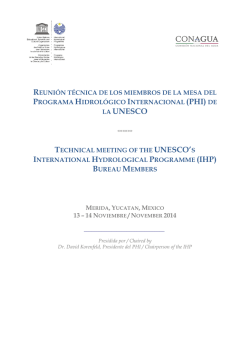
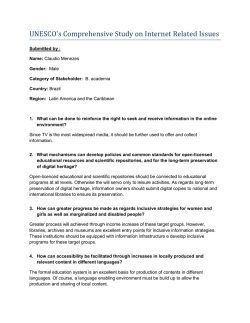

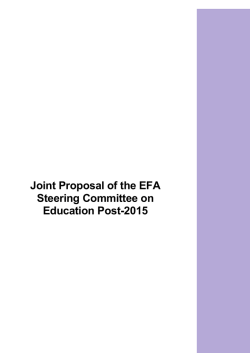
![Flyer on the event [PDF]](http://s2.esdocs.com/store/data/000461133_1-4d88ad04a2122eb11dffd05a58c0a0a8-250x500.png)
